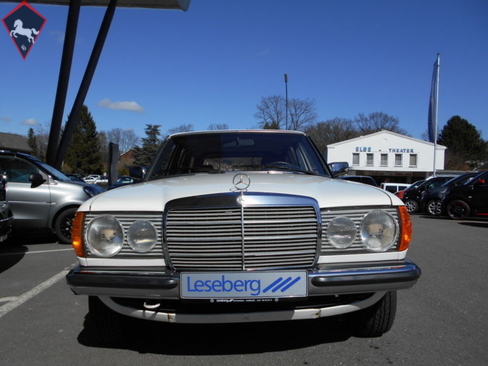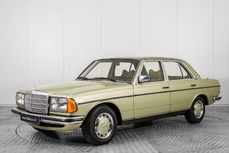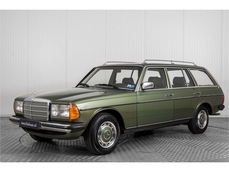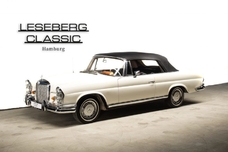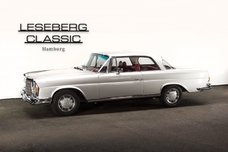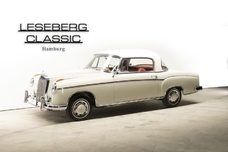Mercedes-Benz 230 w123 TE 1982
General description :
Interne Fahrzeugnr.: OLD1053
Standort: Leseberg Automobile GmbH in Hamburg (PLZ 22549), Leider können wir gute 123er Kombis nicht oft anbieten. Die allermeisten der frühen T-Modelle sind dann doch verschlissen oder exportiert worden. Dieses Auto hingegen befand sich nach stets in Deutschland und ist in sehr ehrlichem, guten Zustand.
Die Laufleistung von knapp 190.000 km ist dem Mercedes nicht wirklich anzumerken. Alle Halter haben dieses Auto offensichtlich gut gepflegt. Die originale Bordmappe ist erhalten und enthält neben einer Betriebsanleitung und dem Händlerverzeichnis auch das Wartungsheft. In diesem sind folgende Einträge zu finden:
Durchsicht am 26.5.1982 bei 1.365 km, Pflegedienst am 4.10.1982 bei 11.894 km, Wartung am 14.3.1983 bei 20.523 km, Pflegedienst am 9.8.1983 bei 30.376 km, Wartung am 27.1.1984 bei 40.228 km, Pflegedienst am 6.6.1984 bei 48.913 km, Wartung am 14.11.1984 bei 60.259 km, Pflegedienst am 31.5.1985 bei 70.081 km, Wartung am 1.10.1985 bei 80.157 km, Pflegedienst am 27.10.1986 bei 90.407 km, Wartung am 4.11.1987 bei 97.589 km, Pflegedienst am 11.1.1990 bei 110.175 km, Wartung am 22.7.1991 bei 123.100 km, Pflegedienst am 20.3.1996 bei 131.721 km, Wartung am 2.9.1992 bei 139.520 km, Pflegedienst am 1.10.1993 bei 150.900 km, Wartung am 18.10.1994 bei 158.707 km, Pflegedienst am 5.3.2013 bei 164.689 km Wartung am 30.10.2010 bei 183.549 km.
Nach den uns vorliegenden Papieren war der Kombi von November 1998 bis Mai 2014 abgemeldet.
Im Rahmen der von uns durchgeführten Wartung wurden die hinteren Bremszangen, alle vier Bremsscheiben und auch der Kühler ersetzt. Das Auto fährt äußerst zuverlässig und sehr angenehm.
Ab Werk umfasst die Ausstattung Automatik, Aussenspiegel rechts, Radio Becker Europa, Servolenkung und Türkontakte an den Fondtüren.
Sonstiges:
Keine Haftung für Druck & Schreibfehler
Irrtum und Zwischenverkauf vorbehaltenpowered by two S
https://home.mobile.de/LESEBERGCLASSICCENTER#des_256234109
1982 Mercedes-Benz 230 w123 TE is listed sold on ClassicDigest in Hamburg by Auto Dealer for Not priced.
Car Facts
Car type : Car Make : Mercedes-Benz Model : 230 w123 Model Version : TE Engine size : 2.3 Model Year : 1982 Sub type : Station wagon Location : Osdorfer Landstrasse 193-217DE-22549 Hamburg
Sold
Seller Information
Sold
People who viewed this Mercedes-Benz 230 w123 also viewed similar Mercedes-Benz listed at ClassicDigest
Other cars listed for sale by this dealer
About Mercedes-Benz
In the annals of automotive history, the journey of Mercedes-Benz is a tale that unfolds with the ingenuity of its founding pioneers. In the year 1886, Karl Benz crafted the Benz Patent Motorwagen, a creation that would go down in history as the world's inaugural automobile. Unbeknownst to him, this moment marked the genesis of what would evolve into the most illustrious premium car manufacturer globally. The financial underpinning of this pioneering venture, interestingly, was provided by Karl Benz's wife, Bertha Benz, demonstrating a remarkable partnership that would set the tone for Mercedes-Benz's legacy.A parallel narrative emerged not far away, as Daimler-Motoren-Gesellschaft, founded by Gottlieb Daimler and Wilhelm Maybach, entered the scene. In 1901, they unveiled their automobile under the now-famous moniker "Mercedes," meaning "godsend" in Spanish. This name was bestowed upon the car at the behest of Emil Jellinek's daughter, the distributor for Daimler-Motoren-Gesellschaft. The wheels of innovation were set in motion.
Fast forward to 1926, a pivotal year that witnessed the merger of Daimler with Benz & Cie., culminating in the birth of Daimler-Benz. The amalgamation saw the adoption of "Mercedes-Benz" as the distinguished trademark for their automobiles, fusing the legacies of two visionary entities into one.
Contrary to perceptions of conservatism, the trajectory of Daimler-Benz unfolds as a chronicle of industry firsts. From the introduction of the honeycomb radiator to the float carburetor, and the pioneering implementation of four-wheel brakes in 1924, Daimler-Benz consistently pushed the boundaries of automotive innovation. The diesel-powered Mercedes-Benz 260 D in 1936 marked the inception of diesel engines in passenger cars. The iconic Mercedes-Benz 300SL Gullwing made history as the first car with direct fuel injection, albeit the Gutbrod's tiny 2-stroke engine can claim precedence.
Safety innovations became a hallmark, with Béla Barényi's patented safety cell design in the "Ponton"-models in 1951, featuring front and rear crumple zones. The W116 450SEL 6.9 saw the introduction of the Anti-Lock Brake system (ABS), another pioneering safety feature. From the first production airbags and beyond, the legacy of "firsts" continued to be etched into the fabric of Daimler-Benz.
Over its centennial journey, Mercedes-Benz has not merely produced cars but has sculpted automotive icons. The SSKL, 710 SSK Trossi Roadster, 770K Grosser, 540K Spezial Roadster, 300SL Gullwing, w100 600 Pullman, w111 280SE 3.5 Flachkühler, w113 230SL Pagoda, w109 300 SEL 6.3, and w201 2.3-16 Cosworth stand testament to the brand's commitment to engineering excellence.
The roaring Silver Arrows, or "Silberpfeile," including the W 25, W 125, W154, W165, and W196, created a legacy of dominance on the racetrack. These machines were not merely cars; they were expressions of precision, speed, and an indomitable spirit that left their competitors in the dust.
As Mercedes-Benz marches into the future, it does so not just as an automaker but as a custodian of a legacy, a torchbearer of innovation, and a beacon of automotive excellence. The road ahead is sure to witness the continued fusion of cutting-edge technology, timeless design, and an unwavering commitment to setting new standards in the world of automobiles.
One luminary figure who left an indelible mark was Béla Barényi, often heralded as the "father of passive safety" for his pioneering work in safety engineering. His patented safety cell design, featuring front and rear crumple zones, became a hallmark of Mercedes-Benz's commitment to occupant safety, setting new standards that reverberated throughout the automotive world.
Moving through the chronicles, the collaborative genius of Wilhelm Maybach, alongside Gottlieb Daimler, laid the foundation for Daimler-Motoren-Gesellschaft. Their innovations not only birthed the first Mercedes but established a culture of relentless pursuit of technological excellence that remains integral to Mercedes-Benz's DNA.
In the post-merger era of 1926, Ferdinand Porsche emerged as a prominent figure within Mercedes-Benz. His work on the Mercedes-Benz S-Type, a supercharged race car, garnered acclaim and set the stage for a legacy that extended far beyond the marque. Porsche's impact would later extend to his eponymous company, but his influence at Mercedes-Benz during those formative years was pivotal.
As the 20th century progressed, the legendary Rudolf Uhlenhaut emerged as a key figure. Uhlenhaut, an accomplished engineer and the driving force behind the iconic Silver Arrows, played a crucial role in Mercedes-Benz's dominance in motorsports. His engineering prowess and attention to detail were instrumental in creating some of the most formidable racing cars of the era.
In the latter half of the century, figures like Bruno Sacco, the head of design at Mercedes-Benz from 1975 to 1999, left an indelible imprint on the brand's aesthetic identity. Sacco's design philosophy, characterized by clean lines and timeless elegance, shaped iconic models like the W126 S-Class and the W201 190E, solidifying Mercedes-Benz's reputation for luxury and sophistication.
The narrative would be incomplete without acknowledging the contributions of engineers like Hans Scherenberg, whose leadership in the 1970s ushered in a new era of technological innovation at Mercedes-Benz. Scherenberg's tenure saw the development of groundbreaking technologies, including the Anti-Lock Brake system (ABS) and the introduction of airbags in production cars.
